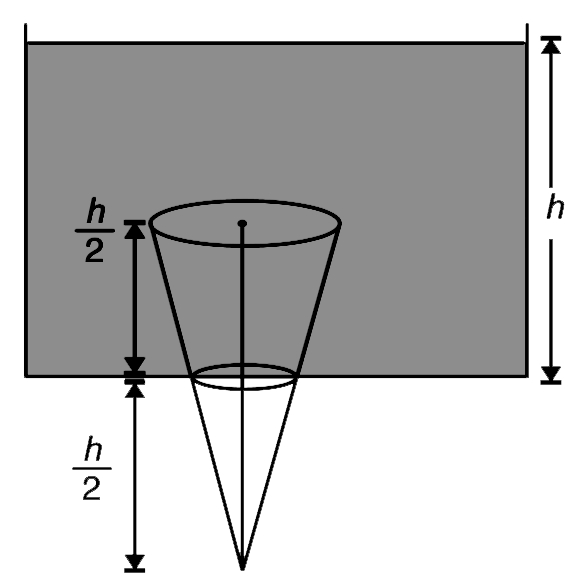A vertical cone of volume V with vertex downwards is filled with water upto half of its height. The volume of the water is V2 (b) V4 (c) V8 (d) V16
To solve the problem of finding the volume of water in a vertical cone filled to half its height, we can follow these steps:
1. Understand the Volume of the Cone:
The volume V of a cone is given by the formula:
V=13πR2H
where R is the radius of the base and H is the height of the cone.
2. Identify the Height of Water:
The cone is filled with water up to half of its height. Therefore, the height of the water h is:
h=H2
3. Determine the Radius of the Water Surface:
Since the cone is similar in shape when filled with water, we can use the properties of similar triangles to find the radius of the water surface r when the height is h.
From the similarity of triangles:
RH=rh
Substituting h=H2:
RH=rH2
This simplifies to:
r=R2
4. Calculate the Volume of Water:
Now, we can find the volume of the water Vwater using the radius r and height h:
Vwater=13πr2h
Substituting r=R2 and h=H2:
Vwater=13π(R2)2(H2)
Simplifying this expression:
Vwater=13πR24⋅H2=13⋅14⋅12πR2H=124πR2H
5. Relate the Volume of Water to the Original Cone Volume:
Recall the original volume V=13πR2H. Therefore:
Vwater=124πR2H=18⋅13πR2H=18V
6. Conclusion:
The volume of the water in the cone is:
Vwater=V8
Thus, the correct answer is option (c) V8.
The volume V of a cone is given by the formula:
V=13πR2H
where R is the radius of the base and H is the height of the cone.
The cone is filled with water up to half of its height. Therefore, the height of the water h is:
h=H2
Since the cone is similar in shape when filled with water, we can use the properties of similar triangles to find the radius of the water surface r when the height is h.
From the similarity of triangles:
RH=rh
Substituting h=H2:
RH=rH2
This simplifies to:
r=R2
Now, we can find the volume of the water Vwater using the radius r and height h:
Vwater=13πr2h
Substituting r=R2 and h=H2:
Vwater=13π(R2)2(H2)
Simplifying this expression:
Vwater=13πR24⋅H2=13⋅14⋅12πR2H=124πR2H
Recall the original volume V=13πR2H. Therefore:
Vwater=124πR2H=18⋅13πR2H=18V
The volume of the water in the cone is:
Vwater=V8
Thus, the correct answer is option (c) V8.
Topper's Solved these Questions
Similar Questions
Let V be the volume of inverted cone with vertex at origin and the axis of the cone is along positive y axis. The cone is filled with water up to half of its height. The volume of water is
View SolutionIf each edge of a cube, of volume V, is doubled, then the volume of the new cube is (a) 2 V (b) 4 V (c) 6 V (d) 8 V
View Solution
Knowledge Check
When a rubber ball of volume v, bulk modulus K is at a depth h in water then decreases in its volume is
AhρgvKBhρgv2KChρgv3KDhρgv4KWhat will be the pH when 0.01 mole of HNO3 is dissolved in V volume of water and V→∞ ?
A1B2C7D0Arrange the following steps in a sequence of find the vlume oof an irregular shaped solid body.
(A). The irregular shaped solid is tied with the thread and is lowered into the measuring cylinder.
(B). A measuring cylinder with graduations in millilitre or cubic centimetrer is taken.
(C). The level of water in the measuring cylinder rises after immersion of the solid. (say V2)
(D) First, it is filled with water to a certain level of volume. (say V1)
(E). The volume of the stone is equal to the difference between the volume of the water before and after the immersion of the stone. (V2−V1).AABCDEBBCADECBDACEDEDACB
Vertex the fixed point V is called the vertex of the cone.
View SolutionA fountain having the shape of a right circular cone is fitted into a cylindrical tank of volume V so that the base of the tank coincides with the base of the cone and the height of the tank is the same as that of the cone. The volume of water in the tank, when it is completely filled with water from the fountain, is V2 (b) V3 (c) V4 (d) 2V3
View SolutionIf the height and radius of a cone of volume V are doubled, then the volume of the cone, is (a) 3 V (b) 4 V (c) 6 V (d) 8 V
View SolutionA water tank has a circular hole at its base. A solid cone is used to plug the hole. Exactly half the height of the cone protrudes out of the hole. Water is filled in the tank to a height equal to height of the cone. Caluclate the buoyancy force on the conc. Density of water is ρ and volume of cone is V.

View SolutionAt a given place two rain drops of volumes V and 8V are falling down with terminal velocities.Their terminal velocities are in the ratio (A) 1:4 (B) 1:8 (C) 1:16 (D) 1:32
View Solution
